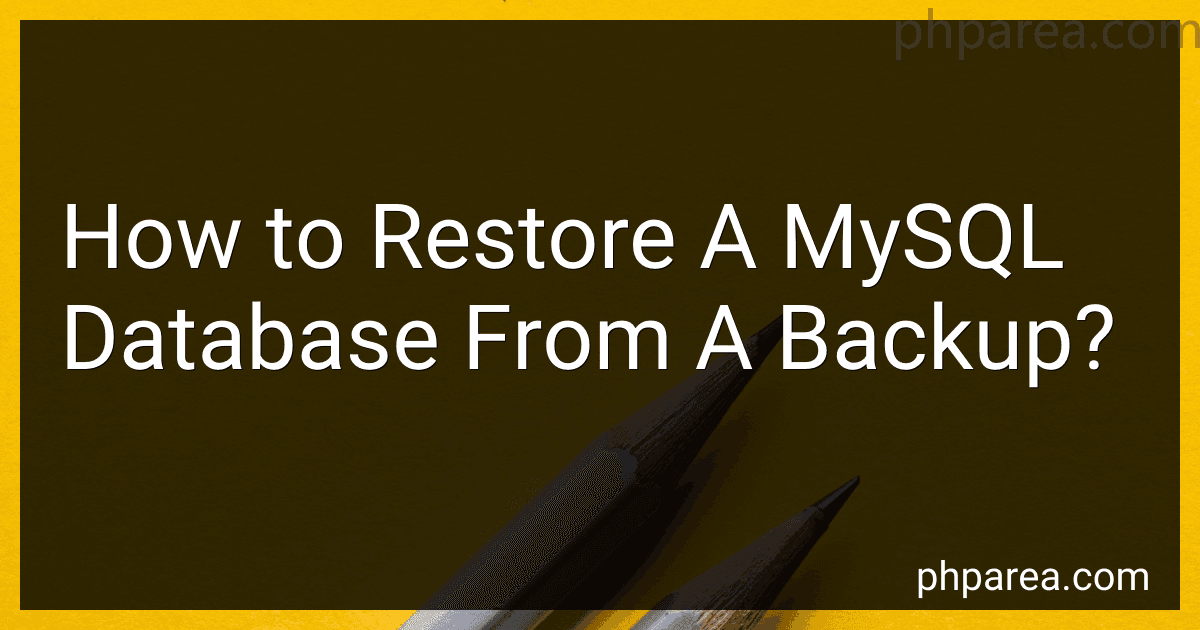Posts (page 118)
-
 6 min readTo grant and revoke privileges in MySQL, you can use the GRANT and REVOKE statements. Here's how you can do it:To grant privileges to a user, you would use the GRANT statement, followed by the specific privileges you wish to grant, and then specify the username and the database or tables that the privileges should apply to. For example, to grant all privileges on a specific database to a user named "john", you can use the following command:GRANT ALL PRIVILEGES ON database_name.
6 min readTo grant and revoke privileges in MySQL, you can use the GRANT and REVOKE statements. Here's how you can do it:To grant privileges to a user, you would use the GRANT statement, followed by the specific privileges you wish to grant, and then specify the username and the database or tables that the privileges should apply to. For example, to grant all privileges on a specific database to a user named "john", you can use the following command:GRANT ALL PRIVILEGES ON database_name.
-
 4 min readTo enable and disable constraints in Oracle, you can use the ALTER TABLE statement. Here is how you can do it:To enable a constraint:Open Oracle SQL Developer or any other Oracle database management tool.Connect to the Oracle database using your credentials and select the specific schema.
4 min readTo enable and disable constraints in Oracle, you can use the ALTER TABLE statement. Here is how you can do it:To enable a constraint:Open Oracle SQL Developer or any other Oracle database management tool.Connect to the Oracle database using your credentials and select the specific schema.
-
 7 min readTo restore a MySQL database from a backup, you can follow these general steps:Create a new, empty database in MySQL where you want to restore the backup.Open a command prompt or terminal and navigate to the location of the backup file.Use the MySQL command line client or a graphical tool like phpMyAdmin to connect to your MySQL server.Once connected, choose the empty database as the target for restoring the backup.Execute the appropriate command to restore the backup.
7 min readTo restore a MySQL database from a backup, you can follow these general steps:Create a new, empty database in MySQL where you want to restore the backup.Open a command prompt or terminal and navigate to the location of the backup file.Use the MySQL command line client or a graphical tool like phpMyAdmin to connect to your MySQL server.Once connected, choose the empty database as the target for restoring the backup.Execute the appropriate command to restore the backup.
-
 4 min readTo back up a MySQL database, you can follow these steps:Use the "mysqldump" command: The mysqldump command allows you to create a text file containing the SQL statements needed to recreate the database. Open a command prompt or terminal and enter the following command: mysqldump -u [username] -p [database_name] > [backup_file].
4 min readTo back up a MySQL database, you can follow these steps:Use the "mysqldump" command: The mysqldump command allows you to create a text file containing the SQL statements needed to recreate the database. Open a command prompt or terminal and enter the following command: mysqldump -u [username] -p [database_name] > [backup_file].
-
 5 min readThe Oracle LIKE operator is used to search for a specified pattern in a column. It is commonly used in queries to retrieve data that matches a certain pattern or contains a specific substring.The syntax for using the LIKE operator in a query is: SELECT column1, column2, ... FROM table WHERE column LIKE pattern;In the syntax, "column" refers to the column you want to search, "table" is the name of the table, and "pattern" is the pattern you want to match.
5 min readThe Oracle LIKE operator is used to search for a specified pattern in a column. It is commonly used in queries to retrieve data that matches a certain pattern or contains a specific substring.The syntax for using the LIKE operator in a query is: SELECT column1, column2, ... FROM table WHERE column LIKE pattern;In the syntax, "column" refers to the column you want to search, "table" is the name of the table, and "pattern" is the pattern you want to match.
-
 8 min readCreating an index in MySQL can significantly improve the performance of queries on large tables. An index is a data structure that improves the speed of data retrieval operations on a database table by providing quick access to the rows that match certain search conditions.To create an index in MySQL for better performance, you can follow these steps:Identify the columns: Determine the columns on which you want to create an index.
8 min readCreating an index in MySQL can significantly improve the performance of queries on large tables. An index is a data structure that improves the speed of data retrieval operations on a database table by providing quick access to the rows that match certain search conditions.To create an index in MySQL for better performance, you can follow these steps:Identify the columns: Determine the columns on which you want to create an index.
-
 8 min readTo perform a join in Oracle, you can use the JOIN keyword in your SQL query. The JOIN operation is used to combine rows from two or more tables based on a related column between them.There are different types of joins in Oracle:Inner join: Returns only the matching rows from both tables. You can use the INNER JOIN keyword or simply use the JOIN keyword without specifying any type of join.Example: SELECT table1.column1, table2.column2 FROM table1 JOIN table2 ON table1.column = table2.
8 min readTo perform a join in Oracle, you can use the JOIN keyword in your SQL query. The JOIN operation is used to combine rows from two or more tables based on a related column between them.There are different types of joins in Oracle:Inner join: Returns only the matching rows from both tables. You can use the INNER JOIN keyword or simply use the JOIN keyword without specifying any type of join.Example: SELECT table1.column1, table2.column2 FROM table1 JOIN table2 ON table1.column = table2.
-
 7 min readTo join tables in MySQL, you can use the SELECT statement along with the JOIN keyword.The JOIN keyword allows you to combine rows from two or more tables based on a related column between them. The related column is typically a primary key in one table that matches a foreign key in another table.There are different types of JOINs in MySQL:INNER JOIN: Returns only the matched rows from both tables based on the join condition. If there is no match, the rows are not included in the result.
7 min readTo join tables in MySQL, you can use the SELECT statement along with the JOIN keyword.The JOIN keyword allows you to combine rows from two or more tables based on a related column between them. The related column is typically a primary key in one table that matches a foreign key in another table.There are different types of JOINs in MySQL:INNER JOIN: Returns only the matched rows from both tables based on the join condition. If there is no match, the rows are not included in the result.
-
 6 min readTo schedule a job in Oracle using DBMS_SCHEDULER, you need to follow the steps mentioned below:Verify Privileges: Ensure that you have the necessary privileges to create and manage scheduler objects. Typically, you will need the "CREATE JOB" privilege and appropriate roles. Create a Program: A program defines the executable and its attributes. Use the DBMS_SCHEDULER.
6 min readTo schedule a job in Oracle using DBMS_SCHEDULER, you need to follow the steps mentioned below:Verify Privileges: Ensure that you have the necessary privileges to create and manage scheduler objects. Typically, you will need the "CREATE JOB" privilege and appropriate roles. Create a Program: A program defines the executable and its attributes. Use the DBMS_SCHEDULER.
-
 9 min readThe WHERE clause in MySQL queries is used to specify a condition that needs to be met for the query to retrieve the desired data. It is commonly used with the SELECT statement to filter the results based on certain criteria.The general syntax of using the WHERE clause is as follows: SELECT column1, column2, ... FROM table_name WHERE condition; Here, column1, column2, and so on represent the columns you want to retrieve from the table_name.
9 min readThe WHERE clause in MySQL queries is used to specify a condition that needs to be met for the query to retrieve the desired data. It is commonly used with the SELECT statement to filter the results based on certain criteria.The general syntax of using the WHERE clause is as follows: SELECT column1, column2, ... FROM table_name WHERE condition; Here, column1, column2, and so on represent the columns you want to retrieve from the table_name.
-
 6 min readTo retrieve data from a MySQL database, you can use SQL queries in your programming language or MySQL command line.Connect to the database: First, establish a connection to the MySQL database using the appropriate credentials (username, password, and host). Execute queries: Once connected, you can execute SQL queries to retrieve the desired data. The most common query for data retrieval is the SELECT statement.
6 min readTo retrieve data from a MySQL database, you can use SQL queries in your programming language or MySQL command line.Connect to the database: First, establish a connection to the MySQL database using the appropriate credentials (username, password, and host). Execute queries: Once connected, you can execute SQL queries to retrieve the desired data. The most common query for data retrieval is the SELECT statement.
-
 10 min readTo create a stored procedure in Oracle, follow these steps:Open a SQL command line or Oracle SQL Developer tool.Connect to your Oracle database using valid credentials.Select the database where you want to create the stored procedure.Begin the procedure creation with the CREATE PROCEDURE statement, followed by the procedure name.Specify any input parameters for the procedure by using the IN keyword followed by the parameter name and data type.
10 min readTo create a stored procedure in Oracle, follow these steps:Open a SQL command line or Oracle SQL Developer tool.Connect to your Oracle database using valid credentials.Select the database where you want to create the stored procedure.Begin the procedure creation with the CREATE PROCEDURE statement, followed by the procedure name.Specify any input parameters for the procedure by using the IN keyword followed by the parameter name and data type.